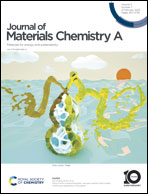Enabling interfacial stability of LiCoO2 batteries at an ultrahigh cutoff voltage ≥ 4.65 V via a synergetic electrolyte strategy†
Abstract
Elevating the cutoff charge voltage (≥4.65 V) of LiCoO2 (LCO) arouses a big challenge between the pursuit of high energy density and long cycling life of LCO-based batteries. Herein, 2,3-dimethylmaleic anhydride (DMMA) as a novel electrolyte additive not only serves as a sacrificial agent to construct a robust and stabilized CEI film enriched with inorganic species (LiF, PO2−, etc.) but also removes the trace amounts of H2O in electrolytes and prevents further decomposition of carbonate-based electrolytes and erosion of LCO. Several advanced characterization techniques such as AFM, XPS, HRTEM, and TOF-SIMS combined with theoretical calculations were applied to reveal the functioning mechanism. It was shown that at a cutoff voltage of 4.65 V, LCO cathode retains 81.6% of its initial capacity (215 mA h g−1) after 300 cycles and 70.7% after 500 cycles at 1C in the presence of 1% DMMA. Moreover, fluoroethylene carbonate (FEC), 1,3,6-hexanetricarbonitrile (HTCN) and DMMA-containing electrolytes are able to further enhance the high-voltage stability of LCO. LCO delivers a high capacity retention of 75.9% after 300 cycles at 4.7 V using the upgraded electrolyte. The synergistic strategy of multiple additives paves a new way to promote the durability of LCO at ultrahigh voltages as well as LCO-based batteries with high energy density.



 Please wait while we load your content...
Please wait while we load your content...